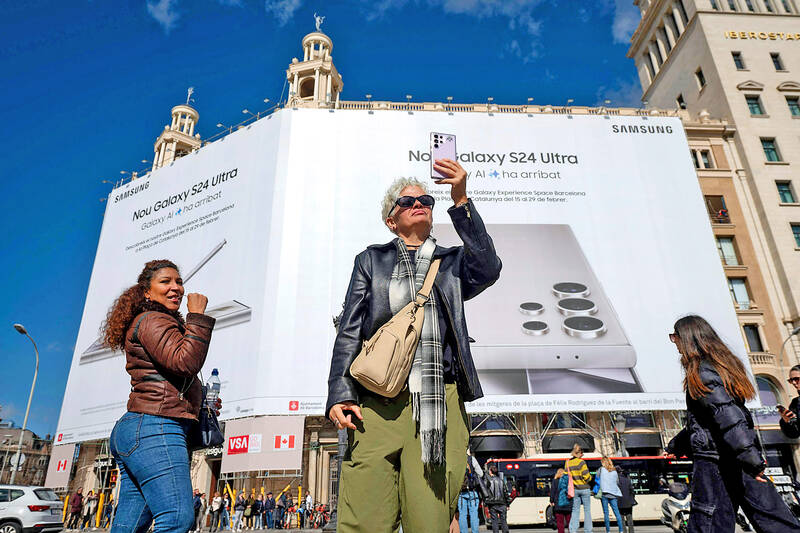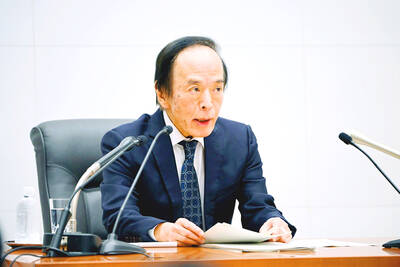The world’s biggest mobile phone fair throws open its doors in Barcelona, Spain, today with the sector looking to artificial intelligence (AI) to try to reverse declining sales.
Phone makers are to focus on the unique AI-powered tools of their latest handsets at the four-day Mobile World Congress (MWC) in Barcelona, where 95,000 attendees and 2,400 exhibitors from around the world are expected to attend.
Telecom operators are expected to use the event to explore how AI can help improve their operations, from boosting security to providing better customer service.

Photo: AFP
AI “is clearly democratizing and is now embedded everywhere: in phones, in devices, in networks,” said Thomas Husson, principal analyst at Forrester Research, adding that it is a reviving innovation in the sector.
The event comes as global smartphone shipments declined 3.2 percent to 1.17 billion units last year. It was the second consecutive yearly decline, as consumers took longer to upgrade their devices due to a lack of innovations, high inflation and economic uncertainties, International Data Corp (IDC) said.
However, shipments rose 8.5 percent in the fourth quarter of last year to 326.1 million units which suggests “momentum is moving quickly toward recovery,” IDC said in a report on Jan. 15.
Google and South Korean giant Samsung Electronics Co have both recently unveiled new flagship handsets with flashy AI-power tools such as advanced photo-editing and easier online search which they are expected to highlight.
Samsung is planning to unveil its first wearable smart ring as part of its health lineup at the MWC, the South Korean firm said yesterday.
The company is to publicly display the Galaxy Ring for the first time after teasing it last month at the Galaxy S24 smartphone series launch in California. The Galaxy Ring offers users more personalized and seamless experiences backed by advances in AI, Samsung said in a statement.
Visitors at the MWC would also be able to see new health features on Galaxy Watch6 series paired with the Galaxy S24, prior to public availability later this year, Samsung said.
The Galaxy Ring’s official launch is expected later this year.
Other smaller handset makers such as China’s Honor Terminal Co (榮耀) are set to unveil new devices at the event. Honor’s new flagship phone features a camera with AI motion-sensing capabilities that can detect and automatically take a picture of a moving object at the best moment.
AI had already “kicked off” before the MWC last year, but “a year later we have a much better idea of how operators and the mobile industry can take advantage of it,” said Peter Jarich, head of intelligence at telecoms industry group GSMA, the event’s organizer.
Among the 1,100 scheduled speakers are Dell Technologies Inc founder and CEO Michael Dell, and Microsoft Corp president Brad Smith.
Aside from AI, discussions are expected to focus on the consolidation of the European telecoms market after the EU on Tuesday last week approved the merger of the Spain operations of French telecoms giant Orange SA with its Spanish rival Masmovil Group.
There is also likely to be debate about whether big tech should contribute to the cost of deploying the networks their products rely on, a notion commonly known as “fair share.”
The annual congress, which has been held in Barcelona since 2006, initially focused on phones but has since expanded to include all sorts of connected devices such as drones and robots. Among the more eye-catching devices which are to be on display is the working model of what US firm Alef Aeronautics Inc said is the world’s first “real” flying car and a lifelike robotic dog by Tecno Mobile that can understand voice commands.
Additional reporting by Bloomberg

Taiwan’s long-term economic competitiveness will hinge not only on national champions like Taiwan Semiconductor Manufacturing Co. (TSMC, 台積電) but also on the widespread adoption of artificial intelligence (AI) and other emerging technologies, a US-based scholar has said. At a lecture in Taipei on Tuesday, Jeffrey Ding, assistant professor of political science at the George Washington University and author of "Technology and the Rise of Great Powers," argued that historical experience shows that general-purpose technologies (GPTs) — such as electricity, computers and now AI — shape long-term economic advantages through their diffusion across the broader economy. "What really matters is not who pioneers

In a high-security Shenzhen laboratory, Chinese scientists have built what Washington has spent years trying to prevent: a prototype of a machine capable of producing the cutting-edge semiconductor chips that power artificial intelligence (AI), smartphones and weapons central to Western military dominance, Reuters has learned. Completed early this year and undergoing testing, the prototype fills nearly an entire factory floor. It was built by a team of former engineers from Dutch semiconductor giant ASML who reverse-engineered the company’s extreme ultraviolet lithography (EUV) machines, according to two people with knowledge of the project. EUV machines sit at the heart of a technological Cold

TAIWAN VALUE CHAIN: Foxtron is to fully own Luxgen following the transaction and it plans to launch a new electric model, the Foxtron Bria, in Taiwan next year Yulon Motor Co (裕隆汽車) yesterday said that its board of directors approved the disposal of its electric vehicle (EV) unit, Luxgen Motor Co (納智捷汽車), to Foxtron Vehicle Technologies Co (鴻華先進) for NT$787.6 million (US$24.98 million). Foxtron, a half-half joint venture between Yulon affiliate Hua-Chuang Automobile Information Technical Center Co (華創車電) and Hon Hai Precision Industry Co (鴻海精密), expects to wrap up the deal in the first quarter of next year. Foxtron would fully own Luxgen following the transaction, including five car distributing companies, outlets and all employees. The deal is subject to the approval of the Fair Trade Commission, Foxtron said. “Foxtron will be

INFLATION CONSIDERATION: The BOJ governor said that it would ‘keep making appropriate decisions’ and would adjust depending on the economy and prices The Bank of Japan (BOJ) yesterday raised its benchmark interest rate to the highest in 30 years and said more increases are in the pipeline if conditions allow, in a sign of growing conviction that it can attain the stable inflation target it has pursued for more than a decade. Bank of Japan Governor Kazuo Ueda’s policy board increased the rate by 0.2 percentage points to 0.75 percent, in a unanimous decision, the bank said in a statement. The central bank cited the rising likelihood of its economic outlook being realized. The rate change was expected by all 50 economists surveyed by Bloomberg. The